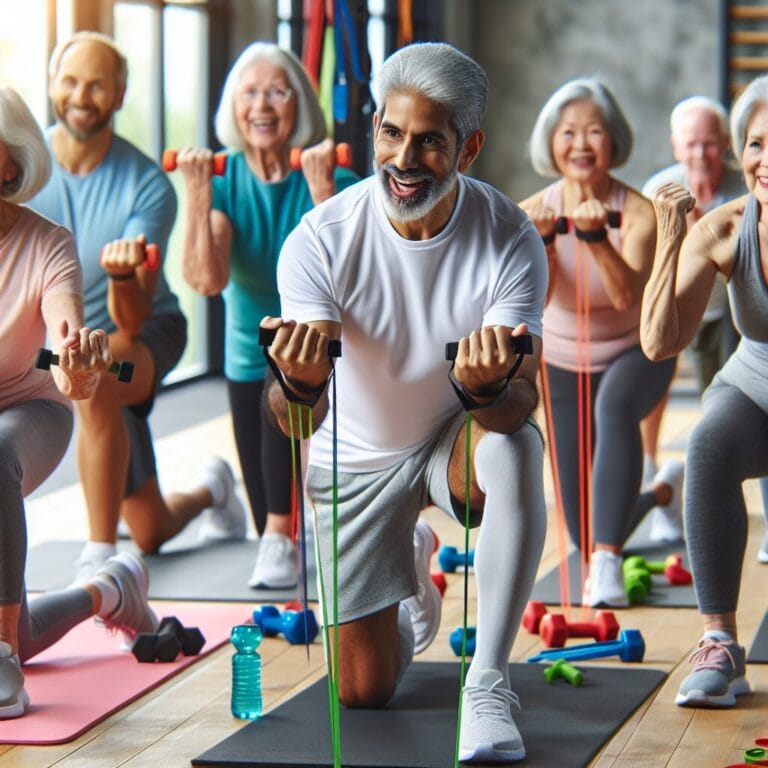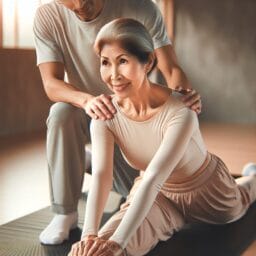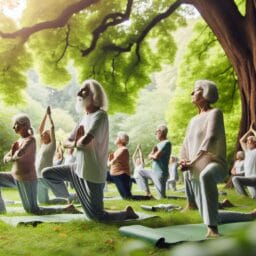
Maximizing Vitality: Strength Training Tips for Seniors
Table of Contents
- Introduction
- Understanding the Aging Process
- Getting Started with Strength Training
- Strength Training Exercises for Seniors
- Safety Tips and Injury Prevention
- Nutrition and Recovery
- Overcoming Common Challenges
- Measuring Progress and Adjusting the Routine
- Conclusion
- Frequently Asked Questions
Introduction
Did you know that engaging in strength training can be like discovering a fountain of youth for older adults? That’s right! Picking up those resistance bands or tackling some strength-building exercises isn’t just about bulking up; it’s about sprinkling a dash of vitality into the golden years. Imagine muscles becoming more robust, balance getting sharper, and daily activities turning into a cakewalk—this is the magic seniors can unlock with tailored strength conditioning.
A personal trainer or a physical therapist with expertise in exercise science can play the role of guide, mapping out a route that’s paved with safety considerations and fun! They create program designs specifically tailored to individual needs, ensuring each senior begins building muscle in the coziest comfort zone before gradually moving up the ranks. This bespoke approach not only helps to gain muscle but can also contribute significantly to life expectancy.
Strength training for seniors isn’t limited to free weights; special exercise equipment isn’t always necessary. Often, simple bodyweight movements, coupled with balance exercises recommended by group fitness instructors or conditioning specialists, do wonders. And we mustn’t forget registered dietitians—they’re like the trusty sidekicks who ensure nutrition isn’t neglected on this journey of improved health and enhanced muscle mass.
Now let’s talk heart—the ticker that keeps us going! Resistance training has shown promising signs in reducing the increased risk of heart disease. Merging strength workouts with an occasional cardio class amplifies this benefit even more. So not only does one get stronger and steadier on their feet, but they also give their heart some love.
In essence, incorporating such important elements as resistance training into seniors’ routines breathes new life into everyday existence. By weaving these threads together—a splash of expert guidance from certified professionals here, a dollop of personalized workout plan there—seniors can uncover an invigorating tapestry that colors every aspect of their lives with remarkable strength and zest for living. Let’s cheers to that impressive gain without any strain!
Understanding the Aging Process
Hey there, did you catch the news? Recent studies have shown that seniors who lift light weights might just be onto something big! As we age, our muscles naturally tend to pack their bags and take a bit of strength with them. But guess what? Regular exercise, specifically strength training, can politely ask those muscles to unpack and stick around longer.
Now, let’s get real—nobody’s saying you need to become a muscle-bound superhero. However, older adults can seriously benefit from incorporating balance exercises and gentle resistance training into their daily grind. It’s not about lifting hefty barbells; even small dumbbells or stretchy resistance bands can lead to impressive results. These workouts help improve balance (no more wobbly moments reaching for that top shelf!) and boost muscle mass which tends to play hide-and-seek as we grow older.
Here’s the lowdown: certified personal trainers and physical therapists—who know a ton about exercise science—are ready to craft a workout plan that fits like your favorite sweater. These plans are super safe because they account for any aches or limitations while still challenging enough to make you feel like the champ you are. And don’t sweat it if fancy gym gear isn’t your thing; body movements using just your own weight can do wonders.
Oh, and remember those munchies after working up a sweat? That’s where registered dietitians enter the stage, ensuring your fridge is stocked with eats that help gain muscle and lose weight (if that’s on your wish list). All these important elements combined mean pushing back against heart disease and adding chapters to our life story.
So next time someone asks why grandma or grandpa is pumping iron, tell ’em they’re smart cookies, investing in their vitality bank for richer golden years ahead!
Getting Started with Strength Training
Ever ponder what secret spice could add some pep to the steps of older adults? Well, strength training might just be that special ingredient! Before diving into the world of resistance bands and balance exercises, it’s essential for seniors to have a heart-to-heart with their healthcare provider. This checkup isn’t just about crossing T’s and dotting I’s—it’s a crucial step in making sure every squat and lift is as safe as Grandma’s apple pie.
Getting started with strength training can feel like setting sail on a vast ocean, but there’s no need to navigate these waters alone. Personal trainers—who are well-versed in exercise science—can help seniors set fitness goals that aren’t only reachable but also packed with fun. Imagine aiming for something as simple as being able to dance at your granddaughter’s wedding or carrying groceries without breaking a sweat. These goals give golden-agers something awesome to work towards!
Choosing the right exercises is key; a certified strength conditioning specialist can hand-pick routines that fit seniors like their best Sunday outfit. These pros know all about building muscle safely, even if someone has creaky knees or a balky back. With tailored plans from personal trainers and insights from group fitness instructors, older folks can enjoy activities designed just for them—from chair yoga stretches that improve balance to gentle dumbbell lifts that beef up those biceps.
And let’s not forget diet—because muscles need fuel! Registered dietitians can whip up meal plans that help gain muscle and manage weight effectively. They ensure every bite counts towards reaching those health milestones.
This delightful combo of expert advice, achievable goals, and personalized exercise regimens makes strength training not just beneficial but also incredibly rewarding for seniors eager to enhance their vitality and keep chasing life with gusto!
Strength Training Exercises for Seniors
Did you know that bodyweight exercises are the unsung heroes of senior fitness regimes? That’s right – no fancy gym memberships or bulky equipment necessary! For older adults looking to spruce up their strength without stepping foot outside their homes, moves like squats, wall push-ups, and seated leg lifts can be pure gold. These nifty numbers help seniors begin building muscle and improve balance with zero fuss. It’s like having a personal trainer tucked in your pocket!
When it comes to resistance training, resistance bands are the bees’ knees. They’re stretchy, easy to use, and oh-so-kind to those precious joints. With a handy band in tow, seniors can pull off workouts that give muscles a challenge without hollering for attention the next day. Plus, they’re as portable as it gets – perfect for maintaining strength on-the-go or while cozying up at home.
But wait, there’s more! Free weights and machines aren’t just for the young whippersnappers at the gym; they’ve got plenty of love for the golden age squad too. When used under the watchful eye of a physical therapist or certified strength conditioning specialist, these tools can do wonders for muscle mass without being tough on tendons. Personal trainers often create program designs with free weights that let seniors gain muscle steadily and safely.
Here’s another thing: safety considerations always come first. Every kettlebell swing and bench press is paired with proper technique coaching from an exercise science expert – keeping risks low while spirits soar high. And should there be any health concerns? Physical therapists are ready to swoop in with modifications faster than you can say “strength-building exercises.”
But lifting weights isn’t all sunshine and rainbows if you don’t eat right too. Enter registered dietitians who ensure nutrition plays its part in this production of well-being by serving up meal plans packed with muscle-friendly munchies.
Incorporating free weights into routine also means waving goodbye (or at least see-you-later) to pesky heart disease – working out isn’t just about what shows on the outside but also keeps that ticker inside running smoothly.
Imagine this: A group fitness instructor guiding a class where laughter mixes with lunges; where balanced meals meet balanced bodies; where every dumbbell raised becomes a toast to longevity and vitality. This is not just exercise – it’s empowerment through endurance training tailored specifically for those embracing their silver streaks.
So let’s get those sneakers laced up because whether it’s hitting up a cardio class now and then or flexing some newly toned muscles – every step taken is one towards boosting life expectancy and swaggering through those senior years with grace and gusto!

Safety Tips and Injury Prevention
Picture this: senior folks at the park, swinging those resistance bands with a smile and getting stronger by the minute. Now, let’s spill the beans on something that might just give your grandpa superpowers—warming up and cooling down. These aren’t just fancy exercise terms; they’re secret weapons for seniors to stay limber and avoid owies while strength training. Starting with gentle stretches gets that blood flowing nicely, and winding down with cool moves keeps muscles as happy as clams at high tide.
But hey, it’s not all about how much you can lift or how many squats you can do. Quality over quantity, right? That means keeping an eagle eye on form and technique is key—like making sure those knees don’t go wandering off past your toes during a squat. And guess what? A conditioning specialist or physical therapist can be like having a form-finding GPS, guiding older adults every step of the way.
Here’s another nugget of wisdom: listen to your body—it knows the score better than anyone else. If it’s telling you to hit the pause button and catch some Zs or chill out for a day (or two), then it’s probably onto something good. Overtraining is like eating too much candy—it seems fun until it isn’t!
By staying sharp on these important elements—warm-ups that hug your muscles awake, form so spot-on it could win awards, and rest that recharges seniors faster than a power nap—the road to muscle mass becomes smoother than ever. So let’s keep those joints joyous and hearts hummin’ while we salute our seasoned citizens turning back time with each weighty lift!
Nutrition and Recovery
Here’s a little-known secret for our beloved seniors: The right munchies and plenty of water might just be the unsung heroes in their quest for strength! Combining resistance training with good nutrition can lead to some serious magic, like muscles getting stronger and the balance becoming steadier. It’s all about giving those workouts a delicious high-five with eats that help repair and power up those hard-working fibers. So, what’s on the menu? Think protein-packed snacks, like grilled chicken or tofu stir-fry, paired with a side of colorful veggies to keep muscles smiling.
But hold your horses—before hitting those strength-building exercises, older adults oughta guzzle down some H2O. Staying hydrated is like oiling up the Tin Man; it keeps everything running smooth during their workout routine. And post sweat-session? More water, please! It helps to wash away any tiredness and gets seniors ready for another round of fun with resistance bands or whatever tickles their fitness fancy.
Now let’s talk Zzzs—because catching quality shut-eye is as important as the exercise itself. Snoozing soundly after a day of lifting light weights helps bodies mend themselves, so when dawn cracks open its eyes, seniors are feeling zippy enough to do it all over again. Good sleep is like a battery recharger for life expectancy—when nighty-night goes well, vitality tends to follow suit come sunrise.
So there you have it—a trifecta of nutrition know-how from registered dietitians, hydration hints from group fitness instructors, and dreamy advice from sleep specialists—that work behind-the-scenes supporting every bicep curl and leg lift. Let’s toast (with a glass of water) to seniors out there gaining muscle and losing weight safely while dancing through their golden years!
Overcoming Common Challenges
Hey, did you know that when older adults team up with pals for a group fitness shindig, it does more than just tickle their funny bone? It’s true! Joining forces with others in a strength training class can be like adding a sprinkle of superhero dust to their workouts. When seniors share laughs and encouragement with fellow band-mates, those resistance bands become less of an exercise chore and more like a ticket to the fun zone!
Strength training isn’t just about getting those muscles beefy; it’s about keeping your heart from working overtime—reducing the increased risk of heart disease while we’re at it. Plus, there’s more good news for our over-60 squad: resistance training can start at any stage, no matter if you’ve got joints that squawk or balance that needs some TLC. Physical therapists are like detectives figuring out which strength-building exercises will make you feel mighty without being mean.
If mobility’s tricky or standing workouts sound as fun as soggy toast, not to worry! Personal trainers who’ve got the smarts in exercise science can whip up special exercise equipment routines that are specifically tailored so folks can begin building muscle right from their chair. And here lies the secret sauce – even when movement is limited, older buddies can still gain muscle mass and possibly lose weight if they want to.
It might seem tough to keep those workout promises to yourself, but here’s a nugget of wisdom: celebrate every tiny victory. Did you lift those weights today? That’s fantastic! Couldn’t do as much as yesterday? No sweat — what counts is showing up and giving it a go! And let’s not forget those registered dietitians who come armed with tasty tricks ensuring snacks support muscle recovery without spoiling supper.
So gather ’round seniors — whether you’re solo or side-by-side with fellow go-getters in cardio class, every stretch and flex is one step closer to feeling spry. Remember this combo: strength training + friendly faces = ripping rewards for muscles and memories alike. Keep fit, stay happy, and let’s raise our water bottles high because together we’re stronger!
| Aspect | Details |
|---|---|
| Group Fitness Benefits | Encouragement, laughter, and social interaction make workouts enjoyable and less of a chore. |
| Strength Training for Seniors | Reduces risk of heart disease, can be started at any stage, and accommodates physical limitations. |
| Adapted Exercises | Physical therapists design exercises for all levels; trainers can tailor routines for seated workouts. |
| Muscle and Weight Management | Resistance training can help build muscle mass and possibly aid in weight loss even with limited movement. |
| Celebrating Progress | Recognize every small victory in your fitness journey; consistency over perfection. |
| Nutritional Support | Registered dietitians provide snack options that aid muscle recovery and fit into a balanced diet. |
| Community and Motivation | Working out in a group setting or with friends increases motivation and contributes to overall enjoyment. |
Measuring Progress and Adjusting the Routine
Gaining muscle and keeping hearts hearty isn’t the only super-cool thing about strength training for older adults. Did you know it’s like adding secret sauce to your daily doings? With muscles more marvy, seniors can zip through chores that used to be tough cookies. But wait—how do savvy seniors keep tabs on their get-up-and-go getting better? It’s simple! Tracking tip-top tricks like how many cans of beans they lift or timing how long they can stand on one leg can show progress that’s as clear as a bell.
When it’s time to jazz things up and skip higher, or press those pesky weights just a tad more, safety considerations dance in the lead. Seniors should shimmy into variety with the help from personal trainers who create program designs that are specifically tailored – think resistance bands today, maybe some light free weights tomorrow. And if those muscles start yawning at the same-old-same-old, seniors shouldn’t shy away from asking a conditioning specialist for new moves that’ll make them say “Wowza!”
Hitting a plateau is no reason to throw in the towel; instead, it’s nudge-time to chat with a physical therapist. They’re fab at figuring out why muscles might be playing hard-to-get and can steer folks back onto the road of progress without missing a beat. Remember, whether aiming to gain muscle or lose weight, variety is the spice of life—and workouts too! So let’s lace up our sneakers, because every step towards stronger self is worth celebrating when life’s playlist keeps playing on repeat.
Conclusion
Strength training isn’t just about muscle magic for older adults; it’s also a golden ticket to fabulous flexibility and bone density that’s tough as nails. Twisting, turning, or reaching up high – resistance training makes these moves smooth as butter, keeping bodies bendy and less brittle. A physical therapist can help weave in balance exercises that turn tipsy walks into steady strolls. And here’s the cherry on top: those resistance bands aren’t only fun to stretch; they’re champions at warding off heart disease and building endurance that outlasts the Energizer Bunny. Older champs listening to their body’s whisper for rest, coupled with munchies approved by a registered dietitian, ensures every effort towards gaining muscle leads to health victories that sparkle brighter than a disco ball! So grab those weights, ace those squats, because every rep is a high-five to your future self saying “Thanks for keeping me sprightly!”




